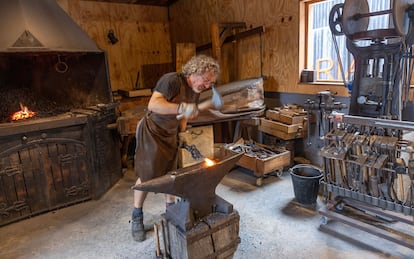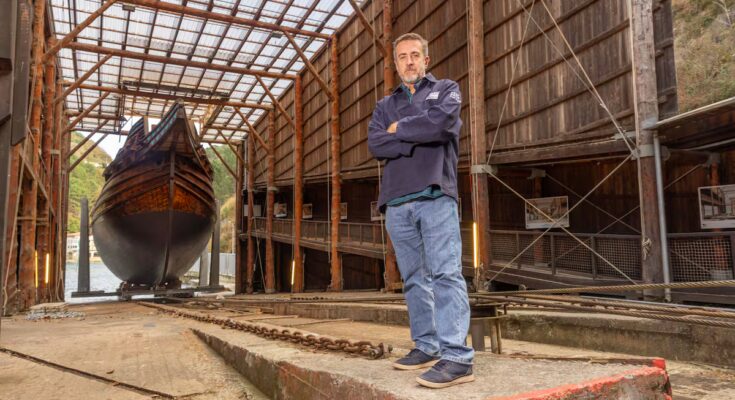We have to go back 500 years, when the all-powerful Charles I and V of Germany ruled, the heyday of the Basque navy. The whaler Saint Johnbuilt in Pasaia (Gipuzkoa), it is the best example. It is one of the first transoceanic merchant ships that then sailed the seas that separated the Basque Country from Newfoundland. Today it is considered a technological excellence of the medieval Basque maritime industry and is about to be reborn. She sank in Red Bay (Labrador, Canada) in October 1565 loaded with nearly 1,000 barrels of whale oil, and remained there forever. It was found at 10 meters deep in 1978 and years later the 3,000 pieces of the ship were catalogued, allowing the characteristics of the hull and the construction techniques of the 16th century to be precisely defined, one of the most extraordinary shows of underwater archeology in history. The ship Saint John She has been rebuilt the old fashioned way for more than 10 years in a modest shipyard in Pasaia and this Friday she will be launched into the water, an event heralded as “an unprecedented event”, says Xabier Agote, president of the Albaola foundation, the alma mater of this “cultural revolution” which managed to recover “the best preserved Renaissance transoceanic ship in the world”.
Him Saint John original, a whaler 28 meters long and 7.5 meters wide, with a carrying capacity of 200 tons, wooded with three masts, three decks with space for 60 sailors and five whalers, remains underwater in Newfoundland-Labrador, protected and monitored to ensure its preservation. The reply of Saint John It is already a reality after 10 years of “tireless, enthusiastic and tireless” work at the Albaola factory, a small shipyard in Pasaia where its architecture has been faithfully reproduced. “You must know that at that time, more than 80% of the maritime fleet of the Spanish Empire was built on the Basque coast. We Basques were the best specialists in the world in building ocean-going ships,” says Agote.
This is “a more beautiful story than that of Moby Dick (the novel Herman Melville),” says Agote on the eve of seeing the Saint John floating in the mouth of the Pasaia. “I’m happy because it will be a very special day,” he comments, referring to the launch of the ship, an event scheduled for this November 7 and which will be attended by the Lehendakari, Imanol Pradales and numerous authorities, including the UNESCO representative of the Ministry of Culture, and envoys from the government and Newfoundland and Labrador. UNESCO itself has adopted the image of Saint John as a symbol of underwater world heritage.
Agote claims that in the Basque Country “the world-wide whaling industry began” in the Middle Ages and that “later the Dutch, Danes and English arrived, copying the techniques used here”: “The nao Saint John “It is the greatest gift that has been given to the Basque Country, it is the greatest emblem of the entrepreneurial character of our ancestors”, says this sea enthusiast, who at the age of 18 went to Maine (USA) to learn the trade of river carpenter and was the promoter of all this “madness” surrounding the most symbolic whaler of Basque navigation. The project, “a life mission” for Agote, required a human and material infrastructure that allowed the reactivation of the professions. almost disappeared, like marine carpentry, blacksmithing, sailing or rope making.
More than 300 volunteers participated in the construction of the whaler Saint Johna huge job that began when Agote got his hands on the cover of the magazine National geographic who revealed the history of this Basque boat in 1985.”16th century Basque whaling in America“, published on the cover. “From that moment on we had to recover all the knowledge of our ancestors, which had been lost over time. Maritime history had to be recovered, the exploits of those builders and sailors valorised. They called us extravagant and crazy, but it was worth it. “It was a marvel to recover the most emblematic Renaissance ship in the world,” says Agote with conviction.
Agote is an enthusiast of sea magic, a devotee of the Elcano and Urdaneta who accomplished historic feats at sea 500 years ago. He led an adventure that will make possible a faithful copy of the Saint John sail the seas again. A bottle of champagne will not be broken, as is customary whenever a ship is launched. “There will be no champagne, but we will spray the hull with cider, which was the drink sailors brought with them on their expeditions in the 16th century,” Agote says.
The launch into the water closes the phase on land and begins the challenge of making it navigable: «From now on, all the remaining work will be done with the boat in the waters of Pasaia Bay. We will have to prepare four kilometers of ropes, two sets of sails of 600 square meters each, we will forge the anchors in a forge similar to those of the time, we will equip it with whaleboats, copper cauldrons, barrels like those that transported whale oil and other equipment… It is about creating a Basque galleon identical to those made in the 16th century. All with the utmost historical rigor”, explains the president of Albaola.
To build the wooden skeleton of the hull, oaks from the Sakana forests (Navarre) and fir trees from the Salazar valley (in the Irati forest, Navarre) were used for the masts. Pitch or tar obtained from pine resin was brought from Quintanar de la Sierra (Burgos) and was used to waterproof the structure of the boat.
The ship’s first mission Saint John It will repeat the journey of 16th century sailors who went to Newfoundland to hunt right whales. The whaler will return to Canadian shores for a voyage scheduled for the summer of 2027. It will be a two-month sea voyage, Agote estimates, and will be boarded with volunteers dressed in period clothing made with the help of Madrid’s Costume Museum. You will travel in conditions similar to those experienced by its occupants in 1565, “without a shower or toilet paper,” says Agote. Following will be a museum ship that will show the public the naval technology of the 16th century, the life on board of those sailors and will reveal what whaling consisted of.
and the rebirth of Saint John It will give way, Agote reveals, to another symbolic challenge for sea lovers: “We will recover the last wooden tuna boat in San Sebastián”. “Him Ozenziyo They should have been demolished 10 years ago, but we managed to stop their destruction. We will carry out a complete restoration of this 20th century vessel which used traditional fishing equipment, which was completely eco-friendly, as it was equipped with perches that caught tuna while the boat was in motion. It’s something exceptional,” ventures Agote.




